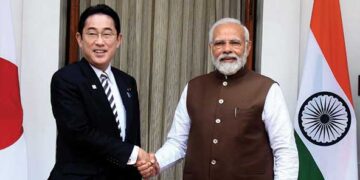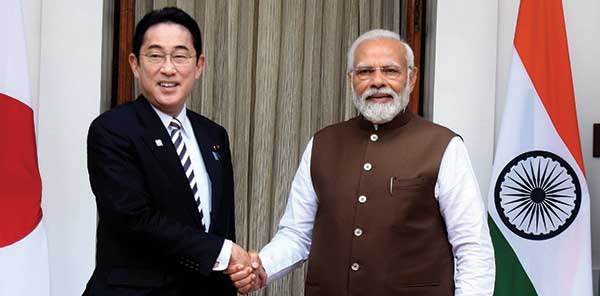 IN A speech – touted by the media as a policy pronouncement – at Sapru House in New Delhi during his recent visit to India, Japan’s Prime Minister Fumio Kishida said, “Viewing Bangladesh and other areas to the South as a single economic zone, we will promote the Bay of Bengal-Northeast India industrial value chain concept in cooperation with India and Bangladesh to foster the growth of the entire region.”
IN A speech – touted by the media as a policy pronouncement – at Sapru House in New Delhi during his recent visit to India, Japan’s Prime Minister Fumio Kishida said, “Viewing Bangladesh and other areas to the South as a single economic zone, we will promote the Bay of Bengal-Northeast India industrial value chain concept in cooperation with India and Bangladesh to foster the growth of the entire region.”
One of the building blocks of this ambitious programme involves a conference in the near future that involves the governments of the North East of India as well as Bangladesh and the private sector from all three countries to chalk out a blueprint for connectivity, operability and development of the region. Officials, quoted by the mainline dailies suggest that Japan’s involvement will also include the development of road infrastructure ‘’in Assam, Mizoram, and Tripura, which will connect to Japaneseassisted projects in Bangladesh’’.
Synergy with Japan vision
In a note on this development, the Japanese Embassy in India said: ‘’India and Japan established the Act East Forum (AEF) in 2017 for the development of the North Eastern region of India (NER) and to promote connectivity within this region and between this region and Southeast Asia. AEF reflects the synergy between India’s Act East Policy and Japan’s vision for a free and open Indo-Pacific. Six meetings of the Act East Forum have taken place so far, while the coordination team meets more frequently for necessary groundwork.’’
The Japan-India collaboration is twofold being part of both the AEF and the Indo-Pacific Oceans Initiative (IPOI). This initiative is described as building upon the ‘Security and Growth for All in the Region’ (SAGAR) initiative announced by Prime Minister Modi in 2015. The Indian Council for World Affairs, where the Japanese Prime Minister unveiled his policy plans, outlines SAGAR as encouraging ‘’states to cooperate and synergise efforts towards a safe, secure and stable maritime domain as also take meaningful steps for the conservation and sustainable use of the maritime domain.’’
North East development
One of the key plans of this ambitious AEF-SAGAR-IPIO thrust is the development of India’s North East through both infrastructure and industrialisation. In fact, it is cheaper to move goods from the region to the other countries in the area and further East than it is to move them into mainland India. Therefore, this idea of an ‘’Industrial value chain connecting the Bay of Bengal and the NorthEastern region of India’’ will bring enormous benefits to the region.
Prime Minister Kishida alluded to his vision of a region that is “free and open” stating that “Northeast India, which is surrounded by land, still has unexploited economic potential.” As part of this vision, Japan has enhanced its bilateral cooperation with Bangladesh where it is helping in the development of the Matarbari deepwater port and improving connectivity in the Bay of Bengal region through the Bay of Bengal Industrial Growth Belt (BIG-B) initiative.
The BIG-B initiative that was enunciated during a summit meeting between Bangladesh Prime Minister Sheikh Hasina and the late Japanese PM Shinzo Abe ‘’Is to accelerate industrial agglomeration along the Dhaka-Chittagong-Cox’s Bazar belt area and beyond, encompassing developing economic infrastructure, improving the investment environment and fostering connectivity. The two Prime Ministers also expected the initiative, with maximum use of Japan’s advanced technologies and socioeconomic development experiences, to yield mutual benefits and prosperity to both countries.’’
Enhancing connectivity
This has seen Japanese involvement in the construction of a multimodal transport hub at Biman Bandar and Kamalapur railway stations plus the development of the Dhaka Metro Rail. For India, the Northeast is the only land link between India and Myanmar, China, Bangladesh and Bhutan. The country has been working to enhance connectivity with the region through rail projects whose progress has been slow. The Agartala-Akhaura rail link that is in the works will help the region ride over its landlocked status and also reaffirm Bangladesh’s emergence as a regional transit hub.
“Japan’s decision to become the lead country for the connectivity pillar of IPOI was a strong reaffirmation of our commitment to the enhancement of connectivity. But on the ground, bilateral cooperation in this area is nothing new. Our two countries have long been advancing various connectivity projects in India as well as in third countries,” Japanese Ambassador to India Satoshi Suzuki said during the inaugural session of a webinar, ‘Connectivity Cooperation towards a Free, Open and Inclusive Indo-Pacific’, sometime back. In essence, that is the process that Prime Minister Modi and PM Kishida are taking forward.
















